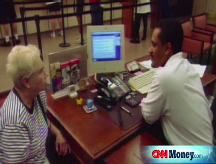U.S. stocks recover after scary open
After an initial plunge, markets turn higher as investors take in an emergency interest-rate cut by global central banks.
NEW YORK (CNNMoney.com) -- U.S. stocks recovered after a sharp drop at the open Wednesday, following the announcement of emergency rate cuts by global central banks.
The Dow, the Nasdaq and the S&P 500 were all up slightly at 9:45 ET. The Dow had dropped more than 200 points - or 2% - at the open.
At 7am ET, the Federal Reserve and central banks in Europe announced they would cut interest rates. The Fed said it was cutting the target for the federal funds rate by a half a point to 1.5%.
Stock futures spiked immediately following the Fed's announcement. The move also brought European stocks into positive territory. But the enthusiasm was short-lived, with futures and European stocks selling off, again, before the U.S. markets opened.
The regulatory moves came after the the world crisis deepened overnight. Asian markets were hurting at the close, with Japan's Nikkei index down about 9.4%, its third-steepest one-day drop ever. Hong Kong's Hang Seng index plunged 8.2%, despite the government's pledge to drop interest rates by one full point.
The Dow could use some good news, having fallen nearly 900 points over the past two days. The blue-chip index shed more than 500 points, or more than 5%, on Tuesday, after Federal Reserve chairman Ben Bernanke warned of more hard times ahead.
Economy: At 10 a.m. ET, the National Association of Realtors will release its August figures pending home sales, a leading indicator of housing activity. Investors aren't likely to get any comfort from this report. A consensus of economists interviewed by Briefing.com expect a dip of 1.2%, compared to a decline of 3.25% in July.
At 10:35 a.m. ET, investors will be watching for the crude inventories report from the Energy Information Administration for the week ending Oct. 4. The Platts survey of analysts projects a drop of 1 million barrels in crude oil stocks, an increase of 2 million barrels in gasoline stocks and an increase of 1 million barrels in distillates stocks. The refinery utilization or run rate is expected to rise 6% to 78.3%.
Retail sales: Wal-Mart (WMT, Fortune 500), the biggest retailer in the world, reported that same-store sales - sales at stores open at least a year - rose 2.4% in September, coming in at the low end of what experts expected. Sales were boosted by purchases of essentials like food and clothing. A consensus of analysts compiled by Thomson Reuters had expected an increase of 2.5%. Wal-Mart had expected a jump ranging from 2% to 3%.
Discount retailer Costco Wholesale (COST, Fortune 500) reported a 7% jump in same-store sales, falling short of the 7.5% increase projected by a consensus of analysts compiled by Thomson Reuters. Costco also reported a 7% jump in fourth quarter profit to $398 million, or 90 cents per share. Still, that fell short of economist expectations of 93 cents per share. Sales jumped nearly 13% to $22.6 billion.
Other companies: Agricultural giant Monsanto (MON, Fortune 500) said that it lost $172 million in its fourth fiscal quarter, or 3 cents per share. That's less than the loss of 9 cents per share that was projected by Thomson FirstCall, in its consensus of analyst expectations. The company said that sales surged 35% to $2.05 billion, beating analyst expectations of $1.9 billion, according to consensus from Thomson FirstCall.
Oil and currencies: The U.S. dollar rose versus the British pound but slipped against the euro and the yen. Oil prices fell $2.28 a barrel to $87.78, as demand worries continue to weigh on sentiment. ![]()


